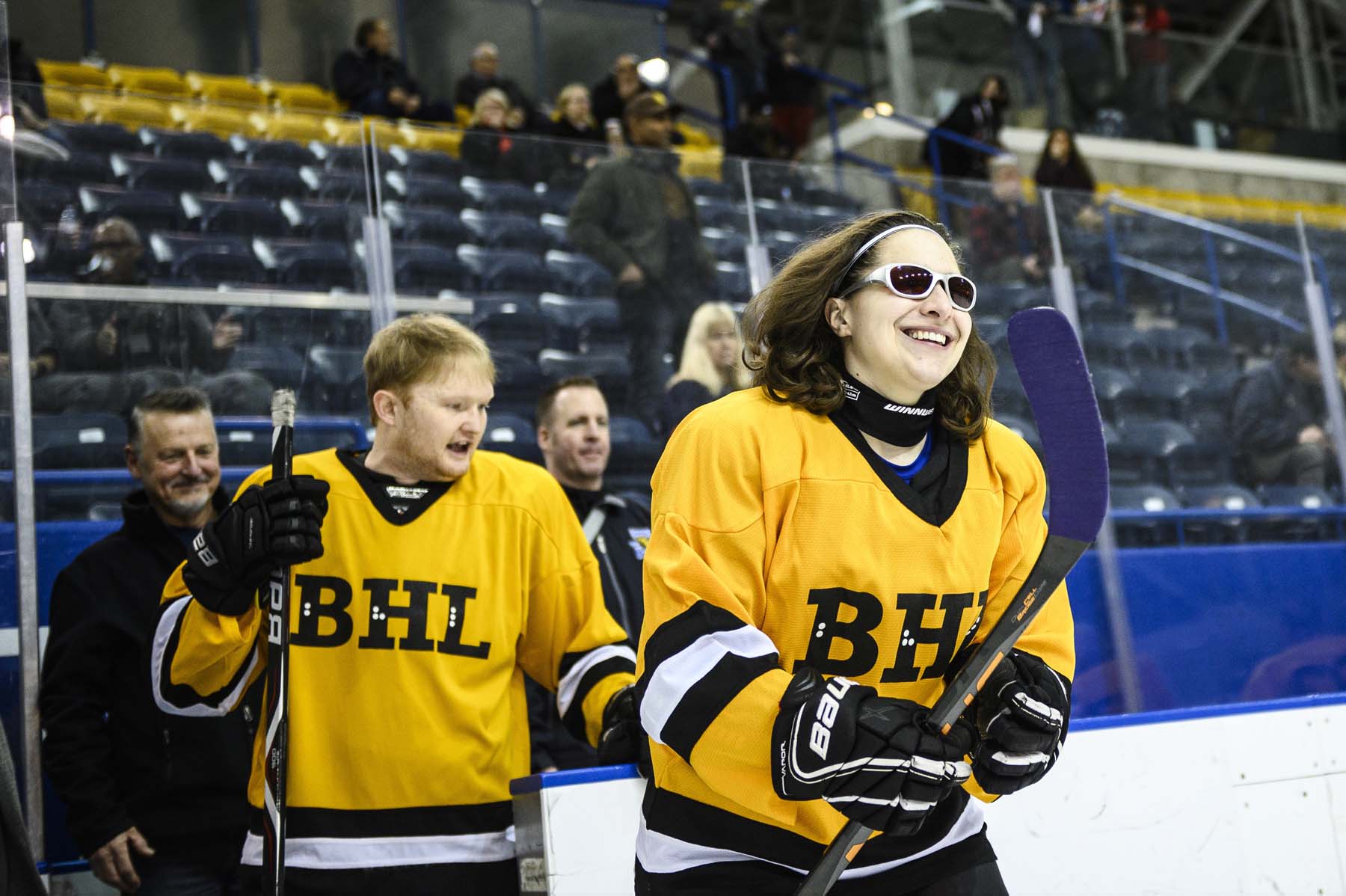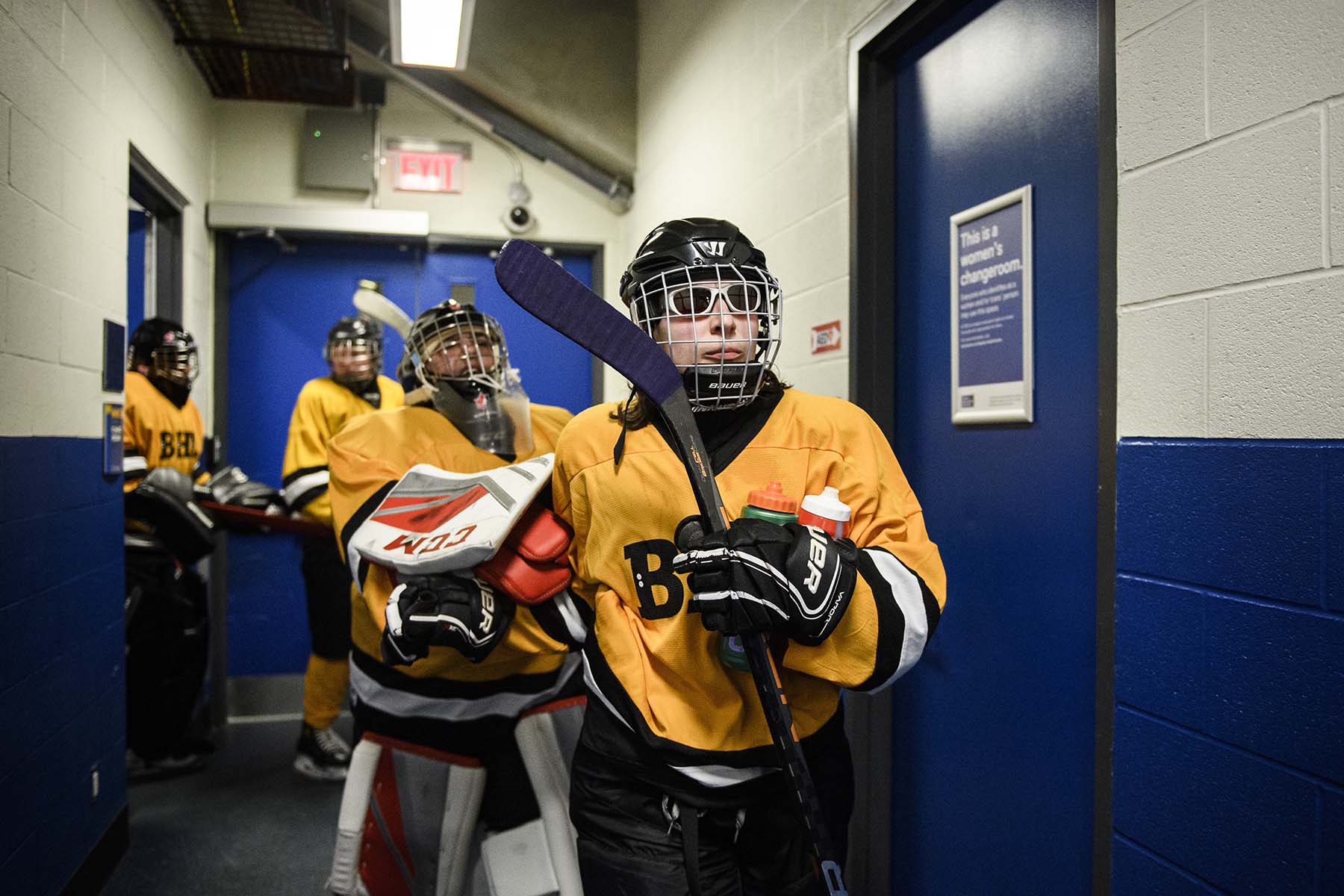The first thing you notice are the sounds, unlike noises at any hockey game anywhere.
As an oversized hollow metal puck glides across the ice, the ball bearings inside jangle, making a cowbell-like noise. It clangs piercingly off the boards, and the referee shakes it in the air to gather players for a faceoff.
Tap to hear sounds of the game
Teammates constantly communicate – talking and tapping their sticks to locate one another. A special whistle signifies one clean pass has been completed, letting players know they can now shoot. When someone scores, there’s a double whistle.
I’m at Toronto’s Mattamy Athletic Centre, at a blind hockey game, an adapted version of Canada’s winter sport, played by blind or partially sighted people. I’m watching a showcase event with the world’s best – everyone has 10-per-cent vision or less, and the goalies are completely blind.
The nets stand three feet high, a foot shorter than a traditional hockey net. A skater leads the goaltender from the dressing room to the net by guiding him by his goalie stick. The camaraderie among the players is unmistakable, as they follow one another onto the ice and banter on their bench.
Joe Fornasier tells me that blind hockey has changed his life. His personal journey is so inspiring it could be a film.
He is a 19-year-old player for Canada’s national blind hockey team, legally blind players who compete against similar athletes from the United States, but he isn’t playing today. Fornasier is wearing a black suit with his arm tucked into a sling, after separating his shoulder crashing into the boards during a scrimmage.
“A lot of these guys played junior hockey before they lost their vision, and they’re not slowing down,” said Fornasier, before an event featuring the best from Canada, the United States and Europe. “I think it’ll amaze you because you might think these guys will be timid, but they’re flying at full speed. It’s the fastest game played by the blind in the world. There’s no other visually impaired sport that moves at this level.”
That fellowship is the draw for many in Canada’s vision-impaired hockey community, including Fornasier.

.jpg)
The Burlington native was fully sighted as a kid and played competitive hockey. At 10, he had trouble seeing during an August tryout, struggling to pick up passes, then noticed his eyesight worsening when school began. Over the next two months, Fornasier lost 96 per cent of his sight, leaving him as he is today, with no central vision and minimal peripheral sight, because of a disease called Leber Hereditary Optic Neuropathy.
“I had a lot of hatred towards the world, even towards hockey, and I never wanted to put skates on again,” Fornasier said. “When I was 14, my Dad learned about blind hockey, but I said ‘no, I don’t want to be associated with anything blind.’ And he said, ‘you can’t put yourself in this box. Just try it.’”


Fornasier tried it, and while it took time to work through his anger, he felt at home on the ice. He joined a GTA youth program and eventually an adult team, the Toronto Ice Owls. By 16, Fornasier became the youngest in history to make the national blind hockey team.
He can see his feet a little, and navigates life without a cane, giving no indication that he’s visually impaired. While skating, he swivels his head, using his peripheral vision to survey as much of the ice as he can. He’s soaked in his teammates’ life experiences, such as how to navigate public transportation and use accessibility apps on his phone. He’s now studying communications at Wilfrid Laurier University, does speaking engagements and has a popular TikTok account.
“I learn more about life with these guys going out for a postgame dinner than I do at a whole semester at university,” Fornasier said. “I can’t drive, I can’t read. I thought that because I was blind, I’d never amount to anything, I could never get a real job. But I have very successful teammates who inspire me.”
Among the teammates to embrace Fornasier was veteran player Mark DeMontis, who had the same eye condition, and lost his vision at 17, when he was a star player in the GTHL, one year shy of a potential NCAA hockey scholarship. In 2009, DeMontis, then 22, founded Courage Canada, which eventually became Canadian Blind Hockey, a charity that provides try-it sessions, development camps and regional and national competitions. It now has some 250 players and 14 programs across the country. More than 1,000 children have tried it. It also has a huge annual national blind hockey tournament – the jewel of the season – for all age groups later this month at the Mattamy Athletic Centre.

The range of vision among players in blind hockey varies widely, especially in grassroots programs. DeMontis describes his own on-ice experience, “like doing your favourite thing, but under water.”
DeMontis talks warmly about his travels with Team Canada friends, when they navigate airports as the sound of blind hockey pucks jangling in their bags becomes a source of curiosity to security staff.
“You go into that dressing room and it’s the same passion, same smell, the same environment,” DeMontis said after the game as the players socialized in a lounge. “Players might not be able to see well but they definitely feel the game like anyone else does playing anywhere in the world.”


Some navigate the arena with limited sight. Some carry a hockey bag with one hand and a white cane in the other. Others use a guide dog, such as the first woman to make Canada’s national blind team, Sudbury’s Amanda Provan and her black lab Ivan. Ivan guides Amanda in everyday life, went into the dressing room with her and watched the game from the handicap seat area at Mattamy, accompanied by Amanda’s mother. But no, he does not go on the ice.
“He’s great emotional support, and he’s very in tune with everything that’s going on, and he loves being at the rink,” Provan said. “The blind hockey community is very close knit. We are like a big family.”
In the following weeks, I visit two other blind hockey events in Toronto and I’m invited on the ice with young players, although I’m fully sighted. DeMontis’s brother Luca, manager of Canadian Blind Hockey’s national team and its youth programs, is at all my stops. The sport is not in the Paralympics, but they hope it will be once more countries develop it. They also strategize for a BHL – or Blind Hockey League – a competition for the world’s best in the discipline.
I visit a field trip for school kids, who are blind or partially sighted, from various Toronto schools and invited to try the sport. They enjoy pizza slices together in the arena’s restaurant before lacing up. Some are debuting on skates. For many, it’s the first time they’ve met other vision-impaired children.
I join the kids in line as we snake through the halls inside this big suburban rink. Some take the arm of a teacher. Some use white canes.
The energetic kids wearing snow pants gather in a dressing room and ask questions before putting on borrowed skates, helmets and gloves. They learn to put the jersey on before the helmet, and that communicating is important. The sport is safe, they’re assured, it’s indoors and no, they can’t fall through the ice.
Getting everyone from the dressing room to the ice, with the help of teachers, parents and volunteer coaches, takes a while. I pitch in.
When I near the net I try to navigate only by feel, and not with my eyes. I’m a long-retired goalie, but the feel of sliding around the crease has stayed with me. Because this hockey net is a foot shorter than a traditional one, the crossbar lines my low back, instead of that feeling I remember across my shoulder blades.
I help a young boy, who is pushing a little red beginner skating device, repeatedly falling and getting right back up. I ask if his hands are cold because he isn’t wearing any gloves. He says he doesn’t want any, then runs his tiny hand across the ice, studying the cold, glassy surface. A sound in the distance catches his attention.
“What’s that banging noise?” he asks.
I tell him that’s the sound of the hockey puck, and some kids have begun playing with it at the other end of the ice.
“I want to go there,” he said.
His pace quickens, and we veer a little off course while travelling the length of the rink. When we veer close to the boards, he reaches out his hand to explore.
“Is that a window,” he asks touching the plexiglass. “Are my parents watching me? Are they taking a video?”
When he reaches the puck he’s delighted and curious, going to his knees so he can touch it. Not yet ready to trade his pusher for a hockey stick, we instead push the puck around, driving it toward the net so he can clang it off the post and run his fingers across the cold bars and the netting.
“We’re not trying to create the next Connor McDavid out here,” Luca DeMontis said. “We’ve got players in our community who are teachers, business owners, even a judge. I always love hearing parents tell me ‘Luca, I now feel confident that my son or daughter can get a career in life.’ For so many years, these children have been put on the back burner because they are visually impaired.”
Days later, I visit a group of blind and partially sighted kids who practise hockey skills every Sunday at Scotiabank Pond at Toronto’s Downsview Park. They use extra big pylons that are more visible for their drills, and coaches tap sticks to help them navigate. As with most blind hockey players, they wear either bright yellow or black jerseys.
.jpg)
Aidan Wood, 22, volunteers as a coach so he can spend Sundays on the ice with his younger brother Dylan, who is 18 and partially sighted and attends a school for the blind.
“The blind hockey puck is heavier, so it does have a little bit more of a push to it,” said the younger brother. “It’s really enjoyable, just being here with people like me and having such a good time, shooting pucks around and doing drills.”
Another regular at these Sunday sessions is 12-year-old Gabriel Alves, who has been playing for five years already. He’s already buzzing about that big annual tournament coming up at Mattamy.
“That’s quite fun,” Alves said. “When someone scores a goal, I like how it sounds when the announcer says their name, like when I score a goal.”
The Globe’s sports reporter, Rachel Brady and Decibel producer Sherrill Sutherland laced up their skates and joined a youth Canadian Blind Hockey program to hear from parents, players and coaches.